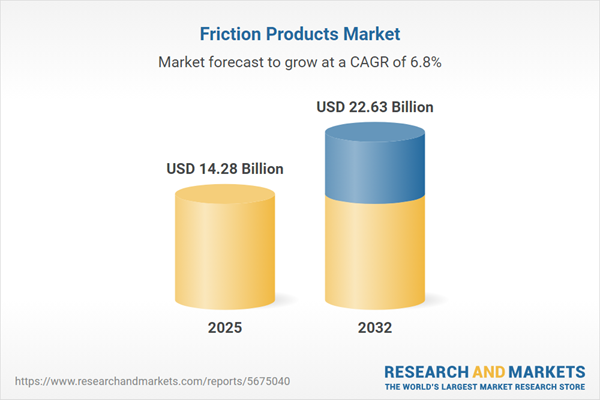Speak directly to the analyst to clarify any post sales queries you may have.
The friction products market is experiencing pivotal changes as industries worldwide focus on technological innovation, safer operations, and sustainability. Senior decision-makers need reliable insights to strategically navigate an evolving competitive landscape and regulatory environment.
Market Snapshot: Friction Products Market Performance and Outlook
The friction products market grew from USD 13.38 billion in 2024 to USD 14.28 billion in 2025. It is projected to continue expanding at a CAGR of 6.78%, reaching USD 22.63 billion by 2032. This steady growth reflects sustained demand for advanced braking, clutch, and surface treatment solutions across automotive, industrial machinery, rail, and aerospace sectors, driven by material innovations and rapidly transforming global supply chains.
Scope & Segmentation of the Friction Products Market
This report delivers a comprehensive examination of the market’s full breadth, segmented by product formats, materials, application industries, distribution channels, geographic spread, and profiled enterprise activity.
- Product Types: Block, Disc, Liner, Pad
- Material Categories: Ceramic (Aluminum Oxide, Silicon Carbide), Metallic (Cast Iron, Sintered Metal, Steel), Organic (Fiber, Resin, Rubber)
- End Use Industries: Aerospace, Automotive, Industrial Machinery, Rail
- Distribution Channels: Offline (Direct Sales, Distributor, OEM), Online
- Regional Coverage: Americas (North America: United States, Canada, Mexico; Latin America: Brazil, Argentina, Chile, Colombia, Peru), Europe, Middle East & Africa (Europe: United Kingdom, Germany, France, Russia, Italy, Spain, Netherlands, Sweden, Poland, Switzerland; Middle East: United Arab Emirates, Saudi Arabia, Qatar, Turkey, Israel; Africa: South Africa, Nigeria, Egypt, Kenya), Asia-Pacific (China, India, Japan, Australia, South Korea, Indonesia, Thailand, Malaysia, Singapore, Taiwan)
- Leading Companies Analyzed: Tenneco Inc., Brembo S.p.A., Aisin Seiki Co., Ltd., Akebono Brake Industry Co., Ltd., Nisshinbo Holdings Inc., Miba AG, Rane Brake Lining Limited, China Automotive Brake Technology Co., Ltd., Mando Corporation, Goetze GmbH & Co. KG
Key Takeaways for Senior Decision-Makers
- Material science breakthroughs, including advanced composites and nano-engineered components, are shaping product competitive advantages and driving application diversification.
- Manufacturers and end-users are increasingly integrating digitalization through simulation-driven design, predictive maintenance, and digital twins, resulting in faster R&D cycles and improved performance reliability.
- Environmental regulations and lifecycle sustainability priorities are influencing the shift towards lower-emission production processes, biodegradable materials, and circular economy practices.
- Partnerships and collaborations between OEMs, material innovators, and technology institutes are enabling custom solutions for modern drivetrains—especially in the context of electric vehicles and high-torque applications.
- Diversified distribution models, combining traditional offline networks with rapidly growing online procurement channels, are helping enterprises adapt to changing buyer behaviors and streamline logistics.
Tariff Impact: Navigating U.S. Regulatory Shifts
The 2025 United States tariff adjustments have significantly affected the friction products supply chain, increasing the costs of key imported raw materials such as ceramic powders and metallic alloys. As a result, companies are revising sourcing strategies, expanding regional supplier negotiations, and investing in domestic processing to mitigate input-cost volatility. These pressures have catalyzed operational efficiencies, from enhanced automation to streamlined design, and encouraged alternative sourcing from neighboring regions. Despite early disruptions, proactive risk management and collaborative procurement frameworks have helped maintain supply chain continuity.
Methodology & Data Sources
The report’s findings are based on robust secondary research, structured primary interviews with value-chain executives, and systematic quantitative analysis. Data triangulation from industry publications, regulatory filings, and peer validation sessions ensures accuracy and actionable insight.
Why This Report Matters
- Enables strategic planning by clarifying technology trends, regulatory impacts, and key market drivers.
- Helps anticipate supply and demand challenges, guiding procurement and innovation priorities for senior leaders.
- Delivers competitive intelligence on partnerships, segment performance, and regional growth opportunities to support resilient decision-making.
Conclusion
As industrial and technological transformation accelerates, targeted insights into material choices, supply strategies, and regional dynamics will define future success in the friction products market. This report equips leaders to proactively navigate complexities and capitalize on emerging opportunities.
Additional Product Information:
- Purchase of this report includes 1 year online access with quarterly updates.
- This report can be updated on request. Please contact our Customer Experience team using the Ask a Question widget on our website.
Table of Contents
3. Executive Summary
4. Market Overview
7. Cumulative Impact of Artificial Intelligence 2025
Companies Mentioned
The companies profiled in this Friction Products market report include:- Tenneco Inc.
- Brembo S.p.A.
- Aisin Seiki Co., Ltd.
- Akebono Brake Industry Co., Ltd.
- Nisshinbo Holdings Inc.
- Miba AG
- Rane Brake Lining Limited
- China Automotive Brake Technology Co., Ltd.
- Mando Corporation
- Goetze GmbH & Co. KG
Table Information
| Report Attribute | Details |
|---|---|
| No. of Pages | 196 |
| Published | October 2025 |
| Forecast Period | 2025 - 2032 |
| Estimated Market Value ( USD | $ 14.28 Billion |
| Forecasted Market Value ( USD | $ 22.63 Billion |
| Compound Annual Growth Rate | 6.7% |
| Regions Covered | Global |
| No. of Companies Mentioned | 11 |









